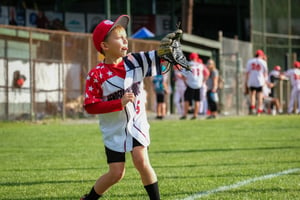Introduction:
Game-Changer: Your Guide to a Successful Career in Sports Analytics
“When you allow kids to collect data on the football field or basketball court, you don’t know who will jump the highest.” John Drazan - STEM Director, 4th Family, Inc., Albany, NY
Career opportunities in sports data science are rapidly growing as sports organizations rely on data-driven decision-making to gain a competitive edge. To prepare for a career in this field, you can start laying the foundation during high school by focusing on certain subjects and skills.
Here's a step-by-step guide:
High School Level Preparation: 
- Mathematics: Develop strong math skills, particularly in algebra, calculus, and statistics. A solid understanding of these subjects is crucial for data analysis.
- Computer Science: Learn the basics of programming languages like Python and R, commonly used in data analysis. Consider taking computer science courses if available.
- Statistics: Familiarize yourself with basic statistical concepts and data analysis techniques. You can find free online resources and courses to help with this.
- Data Visualization: Learn how to create visualizations using tools like Excel or free platforms like Tableau Public. Visualization is an important aspect of data analysis.
- Sports Knowledge: Develop a strong interest and knowledge in sports. Watch games, follow teams, and understand the rules and strategies of various sports.
- Extracurricular Activities: Join math, science, or computer clubs to enhance your skills. If your school offers any sports analytics-related clubs or activities, consider participating in those as well.
- Internships and Volunteering: Look for opportunities to intern or volunteer with your high school or middle school teams, local sports teams, sports analytics organizations, or data-related projects. This will give you practical experience and build your network.
College Level Education:
- Bachelor's Degree: Pursue a degree in a relevant field such as mathematics, statistics, computer science, data science, or a combination of these. Some universities also offer specialized sports analytics programs.
- Advanced Courses: Take advanced courses in data analysis, machine learning, and sports analytics. These will provide you with the technical skills needed in the field.
- Internships: Seek internships with professional sports teams, sports agencies, or sports analytics companies. Internships can help you gain real-world experience and make industry connections.
- Build a Portfolio: Work on personal projects or research related to sports data analysis. Create a portfolio showcasing your data analysis skills and projects.
- Networking: Attend conferences, workshops, and industry events related to sports analytics. Networking can open doors to job opportunities and collaborations.
Career Opportunities in Sports Data Science:
-
Data Analyst: Analyze sports data to provide insights to teams and organizations. You may work with player performance data, game statistics, and fan engagement data.
- Data Scientist: Apply advanced statistical and machine learning techniques to solve complex problems in sports, such as player recruitment, injury prediction, and game strategy optimization.
- Sports Analyst: Provide commentary and insights on sports events using data-driven analysis. This role is common in sports media.
- Sports Analytics Consultant: Work as a consultant, either independently or for a consulting firm, to help sports organizations improve their performance through data analysis.
- Researcher: Conduct research in sports analytics, contributing to developing new statistical models and methodologies.
- Sports Data Engineer: Focus on data collection, storage, and processing, ensuring that sports organizations can access the data needed for analysis.
- Sports Data Journalist: Combine journalism skills with data analysis to write data-driven stories and reports on sports events and trends.

Sports data science is highly competitive, so continuous learning and staying updated with the latest tools and techniques are essential for success. Building a strong educational foundation and gaining practical experience will be key to securing opportunities in this exciting and evolving industry.
Curricula include courses such as Innovation Through New Technologies, Project Cost-Benefit Analysis, and an Evaluation of Quantitative Methods. Some courses will focus on strategic management and consultation topics within the sports analytics field and electives, including expanding on qualitative methods, health care, and evaluation theories.
Example: Sports Performance Analytics Specialization (University of Michigan)
Foundations of Sports Analytics: Data, Representation, and Models in Sports
Use Python to analyze team performance in sports. Learners will discover a variety of techniques that can be used to represent sports data and how to extract narratives based on these analytical techniques. The main focus of the introduction will be on the use of regression analysis to analyze team and player performance data, using examples drawn from the National Football League (NFL), the National Basketball Association (NBA), the National Hockey League (NHL), the English Premier LEague (EPL, soccer) and the Indian Premier League (IPL, cricket).
This course does not simply explain methods and techniques, it also enables the learner to apply them to sports datasets of interest so that they can generate their results rather than relying on the data processing performed by others. As a consequence, the learners will be empowered to explore their ideas about sports team performance, test them out using the data, and so become a producer of sports analytics rather than a consumer.
Moneyball and Beyond
The book Moneyball triggered a revolution in the analysis of performance statistics in professional sports by showing that data analytics could be used to increase team winning percentages. This course shows how to program data using Python to test the claims that lie behind the Moneyball story and to examine the evolution of Moneyball statistics since the book was published. The learner is led through calculating baseball performance statistics from publicly available datasets. The course progresses from the analysis of on-base percentage and slugging percentage to more advanced measures derived using the run expectancy matrix, such as wins above replacement (WAR). By the end of this course, the learner will be able to use these statistics to conduct their own team and player analyses.
Prediction Models with Sports Data
Learn how to generate forecasts of game results in professional sports using Python. The main emphasis of the course is on teaching the method of logistic regression as a way of modeling game results using data on team expenditures. The learner is taken through modeling past results and then using the model to forecast the outcome of games not yet played. The course will show the learner how to evaluate the reliability of a model using data on betting odds. The analysis is applied first to the English Premier League, then the NBA and NHL. The course also provides an overview of the relationship between data analytics and gambling, its history, and the social issues that arise with sports betting, including the personal risks.
Wearable Technologies and Sports Analytics
Sports analytics now include massive datasets from athletes and teams that quantify training and competition efforts. Wearable technology devices are being worn by athletes every day and provide considerable opportunities for an in-depth look at the stress and recovery of athletes across entire seasons. The capturing of these large datasets has led to new hypotheses and strategies regarding injury prevention and detailed feedback for athletes to try and optimize training and recovery.
This course introduces wearable technology devices and their use in training and competition as part of the larger field of sports sciences. It includes an introduction to the physiological principles that are relevant to exercise training and sports performance and how wearable devices can be used to help characterize both training and performance. It includes access to some large sports team datasets and uses programming in Python to explore concepts related to training, recovery, and performance.
Introduction to Machine Learning in Sports Analytics
In this course, students will explore supervised machine learning techniques using the python scikit learn (sklearn) toolkit and real-world athletic data to understand both machine learning algorithms and how to predict athletic outcomes. Building on the previous courses in the specialization, students will apply methods such as support vector machines (SVM), decision trees, random forest, linear and logistic regression, and ensembles of learners to examine data from professional sports leagues such as the NHL and MLB as well as wearable devices such as the Apple Watch and inertial measurement units (IMUs). By the end of the course, students will have a broad understanding of how classification and regression techniques can be used to enable sports analytics across athletic activities and events.



